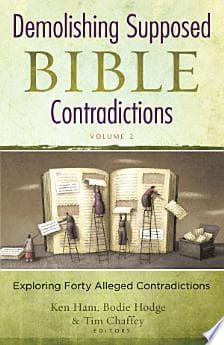- Published on
Demolishing Supposed Bible Contradictions Volume 2
- Authors

- Name
- Tim Chaffey
- @search?q=Tim Chaffey

title: "Summary of Bible Inconsistencies"
Overview
This document provides a comprehensive list of over 700 inconsistencies found within the Bible, drawing attention to contradictions and discrepancies across various books. The inconsistencies range from variations in creation accounts, contradictions in laws and commandments, to differing accounts of events and timelines.
Key Themes
Creation Narratives
- Light Before Sources: The creation of light and separation of day from night on the first day, contrasted with the creation of light sources (the sun and stars) on the fourth day, presents a chronological inconsistency.
Laws and Commandments
- Dietary Laws: Contradictions in dietary restrictions, such as the consumption of certain animals, are noted between Levitical laws and later New Testament teachings.
Historical Accounts
- Genealogies and Timelines: Discrepancies in genealogies, especially in the lineage of Jesus as presented in Matthew and Luke, highlight inconsistencies in heritage and timeline.
Events and Miracles
- Resurrection Accounts: Varied accounts of the resurrection of Jesus, including who discovered the empty tomb and the sequence of appearances to the disciples, suggest inconsistencies in narrative details.
Implications
The presence of these inconsistencies raises questions about the interpretation, translation, and transmission of biblical texts over time. Scholars and theologians often debate the significance and reasons for these discrepancies, suggesting various historical, literary, and theological explanations.
Conclusion
The document underscores the complexity and depth of biblical literature, inviting readers to explore these inconsistencies within the broader context of faith, scholarship, and historical analysis. It encourages a nuanced approach to understanding religious texts, recognizing the multifaceted nature of biblical narratives.
For more detailed analysis and discussion, readers are encouraged to consult the full document and engage with scholarly resources on biblical studies.
